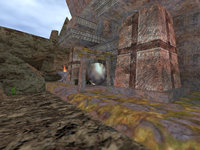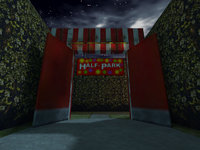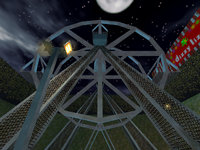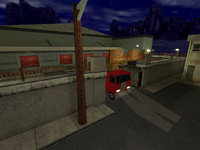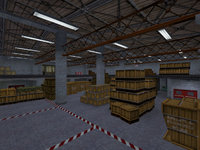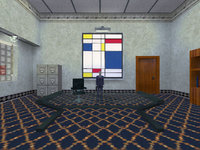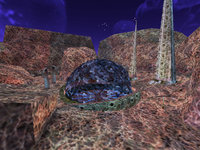Hello, and welcome to ValveTime Articles. In today’s article, we begin with the first installment in a series of interviews with veteran Half-Life mod developers from the past. We’d like to thank Tony Newton for answering our questions.
Introduction
Maverick Developments was a small video game development company based in England. It was established by a group of worldwide developers in 2000, its two main founders being Phil Daniels and Tony Newton. They were responsible for developing a number of modifications for Half-Life, namely Drug Barons, Redemption, and Wanted. In their commercial endeavors, they also worked on the training mission that was featured in the retail version of Counter-Strike, the new levels for the demo version of Gunman Chronicles, and the interactive training software called Tutus, also built on the GoldSrc engine.
What is Redemption?
Maverick is perhaps best known for developing Redemption, a single-player modification for Half-Life released on October 18, 1999.
The storyline directly follows up where the events of Half-Life left off: After Gordon Freeman accepted the G-Man's offer to work for him, it is explained that Gordon’s actions during the Black Mesa incident created a dilemma throughout the galaxy and beyond. When he was sent to Xen to stop the alien invasion of Earth, he had inadvertently released three sacred creatures called Telnorps, the guardians of a portal to another galaxy.
After the Nihilanth’s defeat, the human aid workers sent to control Xen removed some of the borderworld’s artifacts and sold them to collectors on Earth, the Telnorps among them. The gateway left unprotected, an enemy alien race known as the Zan are now on the verge of invading Xen. Gordon is sent by the G-Man to quickly retrieve the three Telnorps and return them to their place in the borderworld to seal the portal between the two warring galaxies forever.
The Telnorps had been separated into distant and diverse locations around the world: a Shaolin temple in the Himalayas, a theme park called Half-Park where alien species are showcased, and a heavily guarded bonded warehouse owned by a powerful and wealthy entrepreneur named Fabio Geussetelli.
You can read more about Redemption at its Combine OverWiki page.
http://combineoverwiki.net/wiki/Redemption
Interview
Could you please tell us a little about yourself for the people who may not be familiar with you and your work?
Sure, but it's not that interesting. I'm currently a 50 year old dude who owns a Web Design agency with my wife Sandra. When I'm not coding web sites, I'm usually out kite buggying with my wife or pottering about with music or doing other 50 year old dude stuff.
When and how did you become a modder? Was there a particular inspiration that lead you to become a modder? What did you do before modding?
Way back in 1998 I was working as a business analyst for a Telecommunication company in New Zealand, when Half-Life came out. I'd just got divorced from my first wife, and was at a bit of a crossroads in life and not particularly enjoying being a business analyst and needed something creative to do. I'd done some Doom and Quake mapping at that point, and discovered that I really liked making maps, particularly single player ones.
I've always had a bit of an interest in lighting, sound design, film and architecture so I found mapping let me use all of those things together. Plus I loved the idea of being able to make virtual worlds that you could walk around inside. I also found the creation process to be extremely rewarding. (Except compiling the maps... which could sometimes take days... that was a pain.)
In those days you were limited to a single 256 color pallet across ALL your textures which was somewhat limiting, and interaction was pretty much limited to "press button, turn on light or open door". Then Half-Life came out, and allowed you to use 256 colours per texture. Back then, that was amazing. The game's AI was streets ahead of anything else around at the time, and it's built in scripting system allowed mappers to make maps that were a lot more "interactive" than they had been for say Quake, without any need for complex scripting or C++ coding. So I started experimenting and joined the Half-Life map making mailing list…
Regarding the development of Redemption and Wanted, were the finished mods close to what you initially planned? Were there any challenges you encountered that changed the direction of the projects? Did any major ideas or concepts have to be cut? Are there any noteworthy development stories you’d like to share?
I met Phil Daniels on the Half-Life mailing list. He too was more into single player stuff than death-match mapping, we got talking over ICQ (remember that!) we swapped a couple of maps, and decided we would collaborate on a small single player pack. We'd both played the USS Darkstar mod by Neil Manke (Black Widow Games), and really liked it. We decided we could do something just as good. I think the original idea was to do a small 3-4 map thing using some of the maps we had already done linked with a very loose story - at least that was the plan. I think I wrote up a one page treatment that outlined the basic story about sacred moths and having to go find them in the Himalayan mountains, it was all very simple B-Grade movie stuff that allowed us to have some cool locations and use some of the existing bits and pieces we had built. It was a story of Redemption - which is how the name came about.
Phil could build maps much, much faster than me. I'm a bit of a perfectionist and would test everything to death, tweak the lighting of a map several times to get it just right, and try and really build atmosphere. Phil was more "throw it together and chuck some lights in", and the concept of testing seemed alien to him. But we quickly found that when we worked together, our combined approaches worked. For example, the Temple map in Redemption was originally one of Phil’s. He built the structure in a day (it would have taken me at least 3), threw in some ninjas, and sent it to me with a "what do you think?".
I remember playing it through the first time and managing to break most of the scripted sequences, and thinking "This map is cool", but the lighting sucked and the scripts got broken because I didn't go through it the way Phil expected me too. There was just no atmosphere - but it had a truck-load of potential and the architectural style was really nice. So I ripped all the lights out and re-lit the map, reworked the ninjas placement and scripting, threw in some ambient sounds of some Tibetan chanting and recompiled it - and it came alive. I still think it's one of the best bits of collaborative mapping we ever did together.
With Redemption, we never really had to cut anything, we just kept adding stuff. We quickly realised that our little 4 map expansion was growing - a lot. So we kind of chunked it up into parts, each set in a different location with a different feel - This was partly to show that we could do different location types and not just Black Mesa clones. I think after a few months we had about 15-20 maps with a few more in the works. I was working on it almost 12 hours a day, I was taking days off work, and staying awake till 3-4 every night. I think Phil was doing the same. I had setup a dedicated machine at home that acted as a compile farm, I wrote a script that allowed me to place maps in a queue to compile while I worked on stuff on my main machine - Back then we were swapping files back and forth by email over dial-up between me in NZ and Phil in the UK. I would do stuff during my day, send it to Phil, who would work on it over my night and I'd get it back the following morning. It actually worked incredibly well.
We were also keeping half an eye on some of the other modders stuff that was coming out and noticing that a lot of the simple play stuff was very buggy. We wanted to be better than that, so I roped in a friend of mine Shaun as a play-tester and we started play-testing our stuff. It often resulted in rework and structural changes.
We also had a need for some custom speech for the characters, notably the G-Man, as the story was now quite complex. I think we tried doing voices ourselves first, but that just sounded terrible. So we advertised for voice acting on the Half-Life mailing list and found the amazing Jordan Weber-Fink who voiced most of the parts for us. He was great to work with. Some of his outtakes are hilarious. We used him for Wanted as well.
Wanted was originally announced as a total conversion for Quake II, but it was later moved to Half-Life engine. How was this transition to a new engine?
Phil had been working on “Wanted” for some time, originally as a Quake mod, and had a lot of the maps already built. We decided to port it all to the Half-Life engine and added some gameplay modes (capture the chicken - an obvious CTF clone, and the "Draw" game modes where two players would get spawned with six shots. I think that was originally my idea, or maybe Mikes, but it's so long ago now I can’t be sure. Either way I loved how that game mode turned out.
Redemption was originally released online as a mod for Half-Life and later re-released as a commercial add-on included with the retail version of Counter-Strike. How did this deal come about?
We released Redemption as a mod after a mammoth 2 day session of working through the night, if I remember rightly, we had PC Gamer Magazine lined up to feature it on their cover disk - hence the deadline. I remember thinking "if we could get this out to a couple of hundred people, that will be so cool". I think we hit 100,000 downloads in the first week, and kept climbing. It was mind-blowing at the time. We were so stoked that our mod was being noticed. Then Valve rang us... They loved the humor in it, and the quality of it and offered to buy it, and have us work with them on some stuff if we were interested. We thought about it for about a second and said "Sure".
Valve advised us to change one particular thing in Redemption, which was at the beginning where the player got briefly teleported accidentally to the start map of Quake II (for copyright reasons as it was going to be a commercial product). I remember emailing Todd Hollenshead at id Software and asking if we could use it. They said they had played it, and loved it (which blew this modder’s mind) but the lawyers said "no" unless Valve paid an undisclosed sum. So in the commercial version (renamed "Absolute Redemption"), you get teleported to Stonehenge. The original version is way funnier and was designed as a real homage to id software. There were other changes but I can’t remember them and they were either quite minor, or just bug fixes.
As it’s evolved quite a bit from the days of Half-Life, do you have any thoughts on the current state of the modding scene?
Not really. I don't have much to do with it. I think from the little I've seen that the tech is getting far more complex than what we had to learn, but the upside is there are far better tools available. And of course the Internet has far more resources available to modders now than we had available back in 1998 and, after the success of games like Half-Life and Unreal, I think game companies take far more notice of the Mod community now that they used to.
From your experience, do you have any tips or advice for modders?
Test. Test. Test. That friend of mine Shaun was the playtester from hell - he would do things that no sane person would attempt and break maps on the first run-through that Phil, Mike and I had played a 100 times. Finding and fixing them before release meant that we didn't have to be endlessly fixing bugs after release. It also meant the player wasn't stuck or frustrated. Which, in turn, meant we got a reputation for quality work. Which is why Valve used us on several projects (well, that and we were probably way cheaper than "real" developers). Despite that there were still some minor bugs in Redemption that snuck in.
Advice... Be prepared for any estimate of how long it will take to get blown out the window by a factor of at least 5. Be prepared to not sleep for months. And if you are in a relationship, be prepared to lose it. If you have friends, prepare to bore them to death talking about nothing but your mod. If you're OK with those risks - Go for it. But above all, make something original, and fun. Part of my disillusionment with the games industry comes down to the lack of originality and endless retreads of a franchise I'm seeing come out. And humor - there just isn't enough "fun" in games anymore in my opinion. Or maybe I'm just jaded…
How does it feel when you see people play and enjoy your work? Do you believe that your work inspired other people to become modders?
I love seeing people play my stuff. Who wouldn't? I'd like to think I inspired some people to try and do something cool. I think the size of Redemption pushed the boundaries of what a Mod was back then, from memory the finished product had 32 or 34 maps in it. Most mods at that time were lucky if they had 4-5.
Is there anything you'd change about your past work?
Hell yes... you can always see flaws in stuff you have worked on. Personally, I never liked Wanted. It wasn't my concept, and because the maps had pretty much all been built by Phil originally for Quake, the proportions were all wrong.
Also I personally didn't have a lot of interest in the game, I wasn't a fan of the western genre, and it felt rushed to me. The textures should have been redone for the Half-Life engine, but instead they were mostly "the same shade of brown" which showed their Quake heritage. They had been hurriedly converted in Photoshop resulting in a pixelated, blocky feel. I think Phil had an idea for wanted in his head, but it didn't translate well for me or Mike Blowers (Mavericks programmer) and I felt the single player game wasn't as strong as it could have been. The two multiplayer game modes were, in my opinion, far more successful.
Do you still work on mods or games?
Not at all. In fact, I have only just started playing games again after a 3 year break. My wife Sandra and I have our own business, so after a full day’s work in front of a PC, the last thing I've wanted to do is spend much more time in front of a computer screen. I've also developed new interests in the last 5 years or so, I tend to spend a lot of time outside flying traction kites and kite buggying, just to get some balance from sitting in front of a screen all day. But having started playing again recently, I'm playing Fallout 4 - and loving it.
Redemption and Wanted and the whole Maverick Developments thing took a huge toll on me, in terms of my health and sanity. We worked stupidly long hours to get Redemption done, and then lurched into Wanted and some other bits and pieces for Valve. The stresses and strains of that workload and trying to do another piece as good as Redemption, and build the company into a functioning studio proved to be too much for all of us and Maverick imploded under the strain.
What is your favorite mod for any game?
Redemption. Hey, it's hard not to love your own baby.
Do you happen to have any materials from the later virtual health and safety applications that Maverick worked on? This may have been after you left, but from what we know, these were also built on the Half-Life engine, and one was called “Tutus”. However, little else is otherwise known or has been seen of these projects.
"Tutus" - strange name choice. That was a product that was originally my idea. We (Maverick) had all gone to E3 in 2001, and I was sitting in a coffee shop in Santa Monica when it suddenly dawned on me that you could use the Half-Life engine to make "real spaces" and gamify health and safety training. It was originally called "Virtual Workplace", but was changed after I left the company. The idea was simple. Create a map that mimics a workplace, and create hazards in it. The player has to go round and identify the hazards simply by "looking at them and clicking the fire button". At the end, there is a score based on the hazards you have identified. We had this idea to either make "generic" maps for industry types, or custom maps for specific locations.
We had a working prototype when I left Maverick, that was successfully used by a local pub for training their kitchen staff, but from what I understand Maverick never quite got it to a commercial product. Which was a shame, as it had huge potential. I had a very clear vision for it, and actually built a second prototype using another engine with physics support shortly after leaving Maverick but was unable to pursue it due to legal reasons.
Maverick also did some work for the MOD in the UK using the Half-Life engine called DIVE (Dismounted Infantry Virtual Environment). I can't say much more about it as it was classified. But that was probably one of the most fun (and profitable) projects we ever worked on as a team.
Credits
Barney and Marphy Black
Special Thanks
Tony Newton for answering our questions
Introduction
Maverick Developments was a small video game development company based in England. It was established by a group of worldwide developers in 2000, its two main founders being Phil Daniels and Tony Newton. They were responsible for developing a number of modifications for Half-Life, namely Drug Barons, Redemption, and Wanted. In their commercial endeavors, they also worked on the training mission that was featured in the retail version of Counter-Strike, the new levels for the demo version of Gunman Chronicles, and the interactive training software called Tutus, also built on the GoldSrc engine.
What is Redemption?
Maverick is perhaps best known for developing Redemption, a single-player modification for Half-Life released on October 18, 1999.
The storyline directly follows up where the events of Half-Life left off: After Gordon Freeman accepted the G-Man's offer to work for him, it is explained that Gordon’s actions during the Black Mesa incident created a dilemma throughout the galaxy and beyond. When he was sent to Xen to stop the alien invasion of Earth, he had inadvertently released three sacred creatures called Telnorps, the guardians of a portal to another galaxy.
After the Nihilanth’s defeat, the human aid workers sent to control Xen removed some of the borderworld’s artifacts and sold them to collectors on Earth, the Telnorps among them. The gateway left unprotected, an enemy alien race known as the Zan are now on the verge of invading Xen. Gordon is sent by the G-Man to quickly retrieve the three Telnorps and return them to their place in the borderworld to seal the portal between the two warring galaxies forever.
The Telnorps had been separated into distant and diverse locations around the world: a Shaolin temple in the Himalayas, a theme park called Half-Park where alien species are showcased, and a heavily guarded bonded warehouse owned by a powerful and wealthy entrepreneur named Fabio Geussetelli.
You can read more about Redemption at its Combine OverWiki page.
http://combineoverwiki.net/wiki/Redemption
Interview
Could you please tell us a little about yourself for the people who may not be familiar with you and your work?
Sure, but it's not that interesting. I'm currently a 50 year old dude who owns a Web Design agency with my wife Sandra. When I'm not coding web sites, I'm usually out kite buggying with my wife or pottering about with music or doing other 50 year old dude stuff.
When and how did you become a modder? Was there a particular inspiration that lead you to become a modder? What did you do before modding?
Way back in 1998 I was working as a business analyst for a Telecommunication company in New Zealand, when Half-Life came out. I'd just got divorced from my first wife, and was at a bit of a crossroads in life and not particularly enjoying being a business analyst and needed something creative to do. I'd done some Doom and Quake mapping at that point, and discovered that I really liked making maps, particularly single player ones.
I've always had a bit of an interest in lighting, sound design, film and architecture so I found mapping let me use all of those things together. Plus I loved the idea of being able to make virtual worlds that you could walk around inside. I also found the creation process to be extremely rewarding. (Except compiling the maps... which could sometimes take days... that was a pain.)
In those days you were limited to a single 256 color pallet across ALL your textures which was somewhat limiting, and interaction was pretty much limited to "press button, turn on light or open door". Then Half-Life came out, and allowed you to use 256 colours per texture. Back then, that was amazing. The game's AI was streets ahead of anything else around at the time, and it's built in scripting system allowed mappers to make maps that were a lot more "interactive" than they had been for say Quake, without any need for complex scripting or C++ coding. So I started experimenting and joined the Half-Life map making mailing list…
Regarding the development of Redemption and Wanted, were the finished mods close to what you initially planned? Were there any challenges you encountered that changed the direction of the projects? Did any major ideas or concepts have to be cut? Are there any noteworthy development stories you’d like to share?
I met Phil Daniels on the Half-Life mailing list. He too was more into single player stuff than death-match mapping, we got talking over ICQ (remember that!) we swapped a couple of maps, and decided we would collaborate on a small single player pack. We'd both played the USS Darkstar mod by Neil Manke (Black Widow Games), and really liked it. We decided we could do something just as good. I think the original idea was to do a small 3-4 map thing using some of the maps we had already done linked with a very loose story - at least that was the plan. I think I wrote up a one page treatment that outlined the basic story about sacred moths and having to go find them in the Himalayan mountains, it was all very simple B-Grade movie stuff that allowed us to have some cool locations and use some of the existing bits and pieces we had built. It was a story of Redemption - which is how the name came about.
Phil could build maps much, much faster than me. I'm a bit of a perfectionist and would test everything to death, tweak the lighting of a map several times to get it just right, and try and really build atmosphere. Phil was more "throw it together and chuck some lights in", and the concept of testing seemed alien to him. But we quickly found that when we worked together, our combined approaches worked. For example, the Temple map in Redemption was originally one of Phil’s. He built the structure in a day (it would have taken me at least 3), threw in some ninjas, and sent it to me with a "what do you think?".
I remember playing it through the first time and managing to break most of the scripted sequences, and thinking "This map is cool", but the lighting sucked and the scripts got broken because I didn't go through it the way Phil expected me too. There was just no atmosphere - but it had a truck-load of potential and the architectural style was really nice. So I ripped all the lights out and re-lit the map, reworked the ninjas placement and scripting, threw in some ambient sounds of some Tibetan chanting and recompiled it - and it came alive. I still think it's one of the best bits of collaborative mapping we ever did together.
With Redemption, we never really had to cut anything, we just kept adding stuff. We quickly realised that our little 4 map expansion was growing - a lot. So we kind of chunked it up into parts, each set in a different location with a different feel - This was partly to show that we could do different location types and not just Black Mesa clones. I think after a few months we had about 15-20 maps with a few more in the works. I was working on it almost 12 hours a day, I was taking days off work, and staying awake till 3-4 every night. I think Phil was doing the same. I had setup a dedicated machine at home that acted as a compile farm, I wrote a script that allowed me to place maps in a queue to compile while I worked on stuff on my main machine - Back then we were swapping files back and forth by email over dial-up between me in NZ and Phil in the UK. I would do stuff during my day, send it to Phil, who would work on it over my night and I'd get it back the following morning. It actually worked incredibly well.
We were also keeping half an eye on some of the other modders stuff that was coming out and noticing that a lot of the simple play stuff was very buggy. We wanted to be better than that, so I roped in a friend of mine Shaun as a play-tester and we started play-testing our stuff. It often resulted in rework and structural changes.
We also had a need for some custom speech for the characters, notably the G-Man, as the story was now quite complex. I think we tried doing voices ourselves first, but that just sounded terrible. So we advertised for voice acting on the Half-Life mailing list and found the amazing Jordan Weber-Fink who voiced most of the parts for us. He was great to work with. Some of his outtakes are hilarious. We used him for Wanted as well.
Wanted was originally announced as a total conversion for Quake II, but it was later moved to Half-Life engine. How was this transition to a new engine?
Phil had been working on “Wanted” for some time, originally as a Quake mod, and had a lot of the maps already built. We decided to port it all to the Half-Life engine and added some gameplay modes (capture the chicken - an obvious CTF clone, and the "Draw" game modes where two players would get spawned with six shots. I think that was originally my idea, or maybe Mikes, but it's so long ago now I can’t be sure. Either way I loved how that game mode turned out.
Redemption was originally released online as a mod for Half-Life and later re-released as a commercial add-on included with the retail version of Counter-Strike. How did this deal come about?
We released Redemption as a mod after a mammoth 2 day session of working through the night, if I remember rightly, we had PC Gamer Magazine lined up to feature it on their cover disk - hence the deadline. I remember thinking "if we could get this out to a couple of hundred people, that will be so cool". I think we hit 100,000 downloads in the first week, and kept climbing. It was mind-blowing at the time. We were so stoked that our mod was being noticed. Then Valve rang us... They loved the humor in it, and the quality of it and offered to buy it, and have us work with them on some stuff if we were interested. We thought about it for about a second and said "Sure".
Valve advised us to change one particular thing in Redemption, which was at the beginning where the player got briefly teleported accidentally to the start map of Quake II (for copyright reasons as it was going to be a commercial product). I remember emailing Todd Hollenshead at id Software and asking if we could use it. They said they had played it, and loved it (which blew this modder’s mind) but the lawyers said "no" unless Valve paid an undisclosed sum. So in the commercial version (renamed "Absolute Redemption"), you get teleported to Stonehenge. The original version is way funnier and was designed as a real homage to id software. There were other changes but I can’t remember them and they were either quite minor, or just bug fixes.
As it’s evolved quite a bit from the days of Half-Life, do you have any thoughts on the current state of the modding scene?
Not really. I don't have much to do with it. I think from the little I've seen that the tech is getting far more complex than what we had to learn, but the upside is there are far better tools available. And of course the Internet has far more resources available to modders now than we had available back in 1998 and, after the success of games like Half-Life and Unreal, I think game companies take far more notice of the Mod community now that they used to.
From your experience, do you have any tips or advice for modders?
Test. Test. Test. That friend of mine Shaun was the playtester from hell - he would do things that no sane person would attempt and break maps on the first run-through that Phil, Mike and I had played a 100 times. Finding and fixing them before release meant that we didn't have to be endlessly fixing bugs after release. It also meant the player wasn't stuck or frustrated. Which, in turn, meant we got a reputation for quality work. Which is why Valve used us on several projects (well, that and we were probably way cheaper than "real" developers). Despite that there were still some minor bugs in Redemption that snuck in.
Advice... Be prepared for any estimate of how long it will take to get blown out the window by a factor of at least 5. Be prepared to not sleep for months. And if you are in a relationship, be prepared to lose it. If you have friends, prepare to bore them to death talking about nothing but your mod. If you're OK with those risks - Go for it. But above all, make something original, and fun. Part of my disillusionment with the games industry comes down to the lack of originality and endless retreads of a franchise I'm seeing come out. And humor - there just isn't enough "fun" in games anymore in my opinion. Or maybe I'm just jaded…
How does it feel when you see people play and enjoy your work? Do you believe that your work inspired other people to become modders?
I love seeing people play my stuff. Who wouldn't? I'd like to think I inspired some people to try and do something cool. I think the size of Redemption pushed the boundaries of what a Mod was back then, from memory the finished product had 32 or 34 maps in it. Most mods at that time were lucky if they had 4-5.
Is there anything you'd change about your past work?
Hell yes... you can always see flaws in stuff you have worked on. Personally, I never liked Wanted. It wasn't my concept, and because the maps had pretty much all been built by Phil originally for Quake, the proportions were all wrong.
Also I personally didn't have a lot of interest in the game, I wasn't a fan of the western genre, and it felt rushed to me. The textures should have been redone for the Half-Life engine, but instead they were mostly "the same shade of brown" which showed their Quake heritage. They had been hurriedly converted in Photoshop resulting in a pixelated, blocky feel. I think Phil had an idea for wanted in his head, but it didn't translate well for me or Mike Blowers (Mavericks programmer) and I felt the single player game wasn't as strong as it could have been. The two multiplayer game modes were, in my opinion, far more successful.
Do you still work on mods or games?
Not at all. In fact, I have only just started playing games again after a 3 year break. My wife Sandra and I have our own business, so after a full day’s work in front of a PC, the last thing I've wanted to do is spend much more time in front of a computer screen. I've also developed new interests in the last 5 years or so, I tend to spend a lot of time outside flying traction kites and kite buggying, just to get some balance from sitting in front of a screen all day. But having started playing again recently, I'm playing Fallout 4 - and loving it.
Redemption and Wanted and the whole Maverick Developments thing took a huge toll on me, in terms of my health and sanity. We worked stupidly long hours to get Redemption done, and then lurched into Wanted and some other bits and pieces for Valve. The stresses and strains of that workload and trying to do another piece as good as Redemption, and build the company into a functioning studio proved to be too much for all of us and Maverick imploded under the strain.
What is your favorite mod for any game?
Redemption. Hey, it's hard not to love your own baby.
Do you happen to have any materials from the later virtual health and safety applications that Maverick worked on? This may have been after you left, but from what we know, these were also built on the Half-Life engine, and one was called “Tutus”. However, little else is otherwise known or has been seen of these projects.
"Tutus" - strange name choice. That was a product that was originally my idea. We (Maverick) had all gone to E3 in 2001, and I was sitting in a coffee shop in Santa Monica when it suddenly dawned on me that you could use the Half-Life engine to make "real spaces" and gamify health and safety training. It was originally called "Virtual Workplace", but was changed after I left the company. The idea was simple. Create a map that mimics a workplace, and create hazards in it. The player has to go round and identify the hazards simply by "looking at them and clicking the fire button". At the end, there is a score based on the hazards you have identified. We had this idea to either make "generic" maps for industry types, or custom maps for specific locations.
We had a working prototype when I left Maverick, that was successfully used by a local pub for training their kitchen staff, but from what I understand Maverick never quite got it to a commercial product. Which was a shame, as it had huge potential. I had a very clear vision for it, and actually built a second prototype using another engine with physics support shortly after leaving Maverick but was unable to pursue it due to legal reasons.
Maverick also did some work for the MOD in the UK using the Half-Life engine called DIVE (Dismounted Infantry Virtual Environment). I can't say much more about it as it was classified. But that was probably one of the most fun (and profitable) projects we ever worked on as a team.
Credits
Barney and Marphy Black
Special Thanks
Tony Newton for answering our questions


